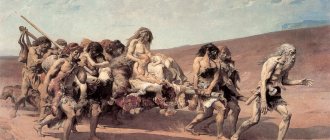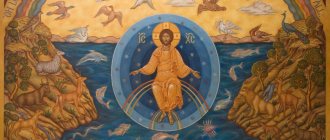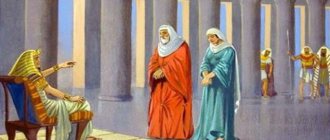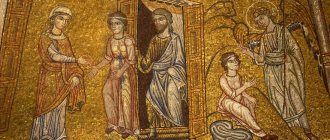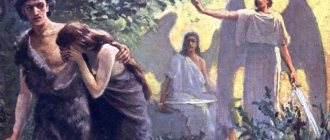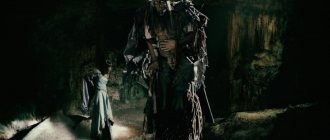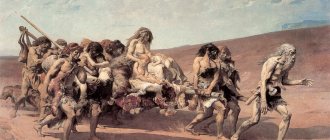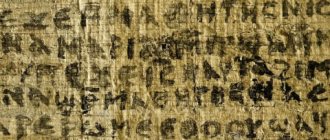According to the Bible, before Eve, Adam had his first wife, Lilith.
Lilith is indeed mentioned in the Bible, although she is not named.
(Gen. 1:27)
“And God created man in His own image, in the image of God He created him; male and female he created them"
It seems that this is talking about Eve, but the point is that this event was described even before her creation. This verse is talking about the sixth day of creation, so the biblical character mentioned is the first woman created by God. Eve will appear later - from Adam's rib.
"Lilith" by John Collier
There is an alternative view of this verse. According to the documentary hypothesis, the Pentateuch of Moses is not an original manuscript, but the result of a merger of four sources:
- Yahwist;
- Elohist;
- Priestly (priestly) code;
- Deuteronomy.
It is the presence of multiple sources that causes many stories in the Bible to be told twice and in different ways (for example, two exodus routes or two lists of the Ten Commandments).
The texts themselves have not reached us, but philologists and source scholars skillfully determine which fragment was taken from where.
Two stories of the creation of the first woman come from different sources:
- According to the Yahwist : the first woman was created from the rib of Adam, her name was Eve;
- According to the Priestly Code : the first woman was created along with Adam in the image and likeness of God.
That is, in the original, these versions were not located together, and therefore can only be different views of the same event.
Interesting Facts
- The creation of man and the images of Adam and Eve have been played out in art many times. The images of the ancestors of mankind on the diptych of the German artist Albrecht Dürer and on the doors of the Ghent Altarpiece by the van Eyck brothers are famous throughout the world. Hieronymus Bosch depicted Adam and Eve on the left wing of the famous triptych “The Garden of Earthly Delights”, which shows the last three days of the creation of the world.
- Molecular biologists have dubbed "mitochondrial Eve" the woman who became the last common maternal ancestor of all living people and lived about two hundred thousand years ago. The mitochondrial DNA of this hypothetically existing lady is shared by all human women, but this does not mean that she was the only “foremother” of humanity, like the biblical Eve. Other women lived at the same time as the so-called “mitochondrial Eve” and also made their own contribution to the gene pool of humanity. Discovery's two-part film "The Real Eve" is dedicated to this discovery.
- In Peterhof there are paired fountains “Adam” and “Eve”, sculpted by the Italian Giovanni Bonazza commissioned by the Russian diplomat Raguzinsky during the time of Peter I. Over the three centuries of their existence, the fountains have not changed and have retained their original appearance.
- In Abrahamic religious traditions, it is believed that Old Testament characters have very real burial places. The ancestress Eve, according to Judaism, is buried in the Cave of the Patriarchs, also known as the Cave of Machpelah, in the ancient part of the city of Hebron on the banks of the Jordan River. Along with Eve, Sarah, the wife of Abraham, Rebekah, the wife of Isaac, and Leah, the wife of Jacob, rest there. And according to the Islamic version, Eve’s grave is located in the city of Jeddah in Saudi Arabia, where there is a place called Hawwa’s Tomb, or Mukbarat umna Hawwah.
- In the Muslim tradition, Eve is called Havva. The Koran says nothing about Adam's wife, she is only mentioned without details. But the details are present in the hadiths, or legends, that tell about the life of the Prophet Muhammad. In this version, the Lord sent Adam and Hawwa to different parts of the world: the man, after the Fall, ended up in India, and the woman in the Arabian Peninsula. It is believed that Havva gave birth not three times, but twenty, and each time - twins. The last thing Havva gave birth to was one son. In total, Havva, according to the Islamic version, had 39 children.
- Asteroid 164, discovered in 1876, is named after Eve.
According to legend, Lilith quarreled with Adam and left him
There are several variations of the legend about Lilith. Briefly and in general terms it looks like this. God created the man Adam and the woman Lilith. But they quarreled. Usually the reason is given as disagreements over intimate life: Lilith did not want to be under Adam, and he did not want to give in to a woman.
This is seen as a reflection of the ancient confrontation between patriarchal and matriarchal societies. Although there is almost no reliable information about actual matriarchal cultures (except that the myths of the Amazons and the veneration of the Mother Goddess hint at such a possibility), yet the patriarchal tradition has always tried to prevent female rule.
But let's return to Lilith. The apocryphal Alphabet of Ben Sira tells about her further fate (we will return to it later).
Amulet from Lilith from the apocryphal book of the angel Raziel
Lilith left Adam. Incorrect translations report that she uttered the name of God and flew away, but in reality there is no talk of any flight. The correct translation of the verb is close to the word “broke out.” There are many interpretations regarding the role of the name of God; it is unnecessary to go into them.
3 angel
according to medieval apocrypha, they pursued the escaped Lilith
Lilith was pursued by three angels. They overtook the fugitive (perhaps her refuge was a cave), but she convinced them not to engage in battle. It is known what the names of the angels were:
- Senoy;
- Sansenoy;
- Semangalof.
These names of angels are found on amulets for protection from Lilith. And, by the way, nowhere else. These angels are called health protectors.
Lilith - Adam's first wife - history and reality of her existence
Hello, friends! Is Eve the first woman and only wife of Adam? No. There is no mention in the Bible that a girl named Lilith was Adam's first wife, but this information is found in more ancient records.
At the Tenth Roman Council, the version of the Holy Scriptures was approved, which later became widespread throughout the world and became canon. It did not include many texts, including the story of Lilith.
A completely logical question arises: if the character appeared in early Christian works, then why was he excluded from the Bible?
The fact is that the story of the first woman is very ambiguous, to a certain extent tragic and sinful. Even the girl's name has a dark connotation. She is associated with true evil, which is why the church simply could not allow mention of her.
Lilith, Adam's first wife, is told in some other traditions. For example, she is one of the important characters in Kabbalah. However, more often it is associated with demonology, with occult teachings and legends about evil dark forces. This is justified due to the transformation that occurs with the character as his story develops.
Is it worth unconditionally believing in the legends set out in ancient apocrypha? Everyone decides for themselves. But it will not be superfluous to get an idea of who Lilith was, what happened to her, and how she is described in different traditions.
Who is Lilith
Who is Lilith? There are several possible answers to this question. They intertwine, intersect with each other and allow you to get an accurate idea of the heroine of myths.
- Lilith is the first woman. Unlike Eve, God created her with clay and fire. Perhaps the fire element endowed her with a strong and somewhat obstinate character.
- Lilith is Adam's first wife. In one version of the story, they lived together only briefly. Another interpretation says that Lilith was a faithful, loving and devoted wife. There is a third way of looking at the relationship between Lilith and Adam. It says that later, when God had already created Eve, the first woman from time to time returned to Adam and entered into sexual relations with him.
- Lilith is one of the supreme demons, the Queen of the Dark World. Traditionally, she is called the wife of Samael (Samael). This name appears in various scriptures and legends. In the classical sense, Samael is the progenitor of demons and the angel of death. Sometimes Lilith's husband is called Satan, the Devil, Lucifer.
- Lilith is the mother of numerous dark entities. Lilith gave birth to legions of lower (minor) demons. She is also sometimes called the mother of all witches and all vampires. In the legends there is an assumption that she gave birth to Cain, leaving him to be raised by Eve and Adam. Other versions of the myths say that Lilith is the wife of Cain, and not his mother.
- In the mysterious book “To him who knocks, let it be opened,” whose authorship remains unknown to this day, Lilith is presented as a kind of thick ethereal or astral body of our planet.
- In various religious traditions, the character is also mentioned, often interpreted as something demonic, associated with darkness, night, spirits and ghosts.
The most famous meanings of the name:
- Night;
- Night;
- Dark (black) femininity;
- Night monster or night creature;
- In the book of Isaiah the name is used to refer to the mysterious ghost of the night;
- Translated from Hebrew, “lilith” means “owl”, “tawny owl”, “owl”.
The Legend of the First Wife
Following the first man, God created woman in his image and likeness. She was distinguished by her beauty, but she was stubborn, freedom-loving and independent. The woman received the name Lilith and became the first wife of Adam. The couple settled in Eden. And, despite the fact that quarrels began to occur between them almost immediately, they lived together for a long time.
Lilith, trying to control her explosive character, largely indulged Adam and obeyed him. She demonstrated as best she could her love for both her husband and the Divine Creator. However, in return, it seemed to her, she received nothing.
Gradually, the desire to be equal to a man in everything overshadowed the virgin’s mind. She demanded that Adam consider her, consult with her, and make decisions with her. In addition, Lilith did not want to be under her husband: she wanted to make love for pleasure, and not for the continuation of the human race, and at the same time be on top.
Angry and offended, Adam told God about everything. The creator also reacted sharply negatively to such demands from the young woman. Then Lilith, not wanting to continue to remain Adam’s first wife and live with him, pronounced the secret name of God - Yahweh. At the same moment, huge wings grew behind her back. She kicked off the ground and flew away from paradise.
The Lord, although he was angry with her act and disobedience, did not want the virgin he created to renounce him. He was ready to forgive her and take her back. By the will of God, three angels set off in pursuit of the fugitive: Semangelof, Sanvi and Sansenoy.
God's messengers caught up with Lilith near the shores of the Red Sea. Initially, they tried to persuade her to return, to apologize to her husband and the Lord. But the girl flatly refused this. The darkness living in her has already completely captured both her heart and mind. The irreversible transformation into a demon has begun.
Despite all the hatred and anger that was seething inside, Lilith, Adam's former first wife, agreed to a “deal” with the angels so that they would not kill her. She declared that she would not be able to harm those children - the descendants of Eve and Adam - who would be protected by the names of angels. She won’t even get close to those whose beds will have signs with her – Lilith’s – names.
Having concluded such an agreement, Senoy, Sansenoy and Semangelof still brutally punished the demoness. The myths set out three versions of punishment:
- Every night for eternity a hundred children will be born and die at once;
- The demoness will not be able to have offspring (punishment by infertility);
- All her offspring will be ugly, sick, or even born demons.
The ancient legend does not say where the main character of the tale disappeared after talking with God's messengers. Its further history is already connected with fallen angels, demons and the progenitor of all evil.
There is a version that the first woman, having lost her beauty and turned into a creature with wings, whose body is thickly covered with hair, flew to Samael. Having become his beloved wife, she got the opportunity to transform from a demonic creature into a beautiful maiden with seductive forms, very sexy and insatiable.
Lilith is often described as a slender young girl with gray (blue) or green eyes. Her hair is long, slightly curly; The curls are either black or fiery red. She is not talkative and is often thoughtful.
Its main functions:
- Murder of babies; Lilith, having lost the “title” of Adam’s first wife, strangles the children, tickles them to death in their sleep, or drinks their blood; sometimes she replaces human children with her offspring;
- Seduction of single boys and married men; the demoness is ready to give them precious moments of pleasure and fulfill all their sexual dreams; she makes them fall in love with her, thereby destroying families or taking the soul from a young man; it is believed that all succubi and incubi came from her;
- The generation of children of Darkness: astral creatures, for example, larvae, lower demons, vampires, witches and so on.
It is widely believed that Lilith is immortal. Because of her ability to shapeshift, the demoness can take on any form, turning into a girl of unearthly beauty, a night ghost, a monster or a beast. She still lives among people. That is why a large number of her children still live on Earth.
Lilith - Adam's first wife - knows neither good nor evil. Unlike Eve, she did not taste the forbidden fruit in the Gardens of Eden; great knowledge was not available to her. Moreover, such a heroine of myths masters magic and is well acquainted with various occult teachings. She knows how to travel to different worlds, squeamishly avoiding only paradise.
Children of Lilith and Adam
In early versions of the legends, the first man and Lilith did not have children. Later, it was suggested that Cain’s mother was not Eve, but the demoness Lilith, Adam’s first wife. This assumption conditionally explains why there was a lot of anger in Cain and why he wanted to kill Abel.
In a literary work written by Dante Gabriel Rossetti, it is mentioned that the heroine of ancient legends became the mother of brilliant sons and sparkling daughters, whose father was the first man created by God. However, this is only a literary text.
Most of Lilith's offspring came from connections with demons, and also, oddly enough, with angels. Her descendants exist freely in the world of mortal men. They are subject to magic, they can kill with just one look and transform into various creatures, they can easily pass through any obstacles and have pyrokinesis.
A minority of the demoness's children were born from copulation with mortal men. Such offspring are distinguished by their explosive character, they are independent from early childhood, and love freedom. They hate daylight, and at night they are able to leave their physical body and travel through the subtle worlds.
There is also a version that one of the first daughters, Lilith, who, according to some theologians and researchers, could have the same name, became the wife of Cain.
About Lilith in different traditions
From the Qabalah point of view, Lilith is not so much Adam's first wife. She is represented as a succubus demoness. On dark nights, she visits young people, copulates with them, being on top. At the same time, it can come not only in reality, but also in a dream. She is also sometimes depicted as a tempting snake.
Within the framework of the Jewish tradition, information often appears that Lilith is not alone. There is the Elder, who is the eternal beloved wife of Samael. And the Younger is the wife of the demon Asmodeus.
In Jewish mythology, they are described as capable of protecting themselves from demonesses. In addition to signs with the names of angels and the names of Lilith herself, the red color protects from her influence. Traditionally, a red thread on the wrist is a talisman not only against all misfortunes, but also specifically against demonic spells.
In ancient times, in order to protect newborns from a night visitor, a protective circle was drawn around the cradles with white chalk (or salt was poured). For boys it was kept for nine days, for girls - at least twenty days.
In the legends and tales of the ancient Sumerians there is a heroine with this name. Who is she? A certain Supreme Goddess who combines good and evil, darkness and light. She acts as the patroness of all Sumerians. When the Goddess cries, new life emerges from her tears. Her kisses are sweet, but can kill.
Based on the Ben Sira Alphabet, it was possible to compile a list of names given to the creature. Here are some of them:
- Amorpho – formless, spirit;
- Batna, means "womb";
- Cle Ptuza – child abductor;
- Odem – red, fiery, redness;
- Khods – able to fly, winged.
There is a mention of the character in the Epic of Gilgamesh, in Arab folklore records and in the tales of the ancient Greeks. Among the latter, the demoness Lilith, the first wife of Adam, according to one theory, appears under the name Lamia.
In view of the material presented above, the question “why is it considered a bad maiden created from fire and clay?” is no longer relevant. And due to the fact that the image of the heroine of ancient legends is reflected in demonology, Lilith, in principle, is not easy to perceive as a character at least somewhat positive and kind.
Lilith in demonology
In teachings related to evil forces and Darkness, the name of the demoness appears very often. It is practically not mentioned only in the satanic direction created by Anton Sandor LaVey.
In other demonological traditions, Lilith appears not as the first wife of Adam, but as the Supreme Demoness, the wife of Satan, the mother of all demons and night witches. She is the imperious and powerful Queen of Darkness.
Some researchers believe that it is appropriate to include Lilith in the world list of ancient Black Goddesses, which include, for example, Hel and Kali.
Demonology also adopted the idea of two beings of that name, which is mentioned in the Kabbalah. This view of the character is present in the book "Luciferian Witchcraft".
In the publication from the Temple of Black Light, Satan's wife is one of the eleven supreme demons. She is the ancestor of Princess Naamu. She bears the title of the Supreme Queen of the Dark Dimensions and the Princess of Chaos.
In the dark writings created by the followers and priests of the Temple of Lilith, it is said that the demoness is the Mother of Life and the Mother of Death. It is interesting that this interpretation is very consonant with the idea of the ancient Sumerians about Lilith, the first wife of Adam.
In The Complete Book of Demonolatry, the one who left God is presented as the Crown Princess or Princess of Hell. She is also one of the ten most powerful demons.
In demonological teachings, the name of the demoness is interpreted as a collective name. It contains a reference to three Sumerian demons:
- Ardat Lily;
- Lilu;
- Lilitu.
Opinion of a deacon of the Orthodox Church about Lilith
Andrey Vyacheslavovich Kuraev (February 15, 1963, Moscow) - protodeacon of the Russian Orthodox Church; professor of the Moscow Theological Academy; senior researcher at the Department of Philosophy of Religion and Religious Studies, Faculty of Philosophy, Moscow State University; writer, theologian, philosopher and publicist, secular and ecclesiastical scientist, preacher and missionary, author of the official textbook on the Fundamentals of Orthodox Culture. Cleric of the Church of the Archangel Michael in Troparevo.
Rabbi's Opinion on Lilith
Thank you, friends, for your interest in the material and for reading the article. Leave comments and share the post with friends on social networks. Be sure to subscribe to updates on our site. All the best to you, goodbye!
Another biblical character, the Queen of Sheba, is sometimes identified with Lilith
There is a tendency among commentators and Bible scholars to simplify: to declare everyone to be brothers and sisters, and to identify as many characters as possible with each other. For example, the tempting snake is often called Satan, which is unfair.
In translations of the Bible into Aramaic and the Kabbalistic tradition, Lilith, being a demon, sometimes turns into the Queen of Sheba. This is how she seduces the righteous.
These are late interpretations that a serious researcher should not take into account.
The Queen of Sheba is sometimes identified with Lilith, although there is no reason for this (artist Edward Slocombe)
Lilith is called the first Eve, and she may also be the first woman on Earth
It is noteworthy that Lilith is sometimes called the first Eve, but Eve is never called the second Lilith.
It is interesting to think about who is the first woman on Earth: Eve or Lilith? Both were created before God expelled humanity from the Garden of Eden. But Lilith left Adam earlier. If we rely on the legend that she ended up in the desert or the Red Sea, then she may indeed be the first person on our planet.
Lilith as imagined by a contemporary artist (Sergey Kolesnikov)
However, this is unreliable ground to take legends literally. Moreover, the Bible never directly stated that these people were the only ones. It is possible that Adam had contemporaries who were simply not mentioned in the Holy Scriptures.
Futile Pursuit
What do abandoned husbands do in such cases? That's right, they are looking for someone who would make up for his loss and console him in his grief. But there was no such thing in the Garden of Eden, since the only woman was Lilith. This forced Adam to turn directly to the Creator and ask Him to create a replacement for her.
Before starting to create Eve, the Lord tried to return the fugitive and sent three angels in pursuit of her. God's messengers managed to reach it only on the shores of the Red Sea, and given that the Garden of Eden, according to theologians, was located somewhere near either the Armenian Highlands or Southern Mesopotamia, it took a long time to fly. However, all the work was in vain, since the obstinate woman flatly refused to fulfill God’s command and declared that she no longer wanted to know this oppressor of her women’s rights.
The origin of the image of Lilith goes too deep into history
It is impossible to find out anything about the original image of Lilith. It is so ancient that there are simply no surviving sources for successful research. In addition, what is required is not just archaeological research, but a thorough interdisciplinary study, which will involve specialists from a variety of fields:
- Archeology;
- Story;
- Mythology;
- Cultural studies;
- Epigraphy;
- Religious Studies;
- Esoterics;
- Psychology;
- Astrology;
- Alchemy.
And here the reader has the right to demand an explanation. Okay, history, archeology, but what do psychology and astrology have to do with it? It's simple:
Lilith in astrology is identified with the black moon, an imaginary satellite of the Earth. Astronomy does not confirm its existence. But astrologers say that the luminaries influence a person’s character. If there is a certain planet in the astrological chart, this will affect the character. Some specialists in this field do the opposite: they detect the influence of
- a certain black moon, which is why they claim its existence. But more often it is taken as a convention;
Symbol of the Black Moon Lilith - an imaginary planet in astrology
- Lilith in psychology is identified with anima. This is an archetype, the feminine principle in a man. He is the source of the sensual and is capable of manifesting himself in dreams. Sometimes anima is divided into positive and negative, with Lilith acting as the negative part.
In ancient times there was a cult of the goddess Lilith
Although the roots of the image of Lilith cannot be traced, we can speak with confidence about who this legendary woman is. Any cult is a ritual and the myth underlying it. We know nothing about the ritual of Lilith and have only an echo of what was the myth that founded it. But even this is enough to appreciate the significance of the deity Lilith.
She was clearly a Mother Goddess, one of the first. This is hardly an evil deity, but at the same time she is a frightening, otherworldly deity that requires reverent respect. There is a certain chthonic spirit in it, although, of course, such statements are close to speculation, there is nothing to substantiate them.
"Lady Lilith" by John Collier is one of the most famous images of Adam's first wife.
But we can confidently conclude that Lilith came to Semitic culture from an older Babylonian tradition, and there from even earlier beliefs. Of course, that Lilith, the demon that we have in the Jewish written and oral heritage, has little in common with its prototype.
It is hardly possible to restore the image of the original Lilith, but we can get close to the documented extreme point.
Demon of night
Two centuries later, the image of Lilith changed somewhat. In Jewish religious literature, as well as in folklore, she began to be represented not as a snake, but as a kind of demon ─ the spirit of the night. By the way, the name Lilith itself is translated from Hebrew as “night.” It especially often affects men who sleep alone or wander alone on night roads.
She appears to them in the form of a silent and beautiful woman with long flowing black hair. Her relationship with the leader of the demons, Samael, also changed. If in earlier times they were considered lovers, then around the 15th century she became his “legal” wife.
The first hypostasis of Lilith is a vampire and strangler of children.
As a Mother Goddess, Lilith is associated with motherhood, but she is also a rather strange mother by human standards. If the reader knows, he will immediately remember the Greco-Roman Kronos-Saturn - the god of time, who devoured his children.
This image is clear to us and does not raise questions: time is all-consuming, it gives life and destroys it. Perhaps this image indirectly goes back to the original cult of Lilith - the giver and taker of life.
The image of a Mother goddess like Lilith is sometimes difficult to interpret from the outside. For example, the iconography of the goddess Kali is very complex, and few people will understand it correctly
There is a similar image in Hinduism. Goddess Kali is the Great Mother, but she is also the destroyer of the false ego, the goddess of the cessation of material existence. But there is nothing destructive and final in this act of death, since dying is a transition to the spiritual sphere, which means that there are no negative connotations in the image of the killing Mother. Only demonic entities, attached to a false ego, mired in material sins, who have become their slaves, if we speak in Christian terms, should fear it.
But in the case of Lilith, it is noteworthy that she kills only children. It does the following:
- Smothers;
- Drinks blood;
- Gnawing on bones.
This is difficult to interpret unambiguously and there are hardly any positive interpretations. It is this negative hypostasis of Lilith that is widely known in the ancient world:
- among the Sumerians;
- among the Hittites;
- among the Assyrians;
- among the Babylonians.
In the written sources of the Babylonians, this hypostasis is best known under the name Lamashtu. The myth describes this goddess:
“she is sinister, she is stubborn, she is a goddess; she's terrible. She is like a leopard, daughter of Anu. Her feet are like those of the (bird) Zu, her hands are dirty, she has the face of an all-powerful lion. She rises from the reed thickets. Her hair is down, her breasts are exposed. Her hands are smeared with blood and flesh. She comes through the window without asking, she crawls like a snake. She sneaks into the house and leaves it again.”
Lamashtu is a goddess whose features are very similar to Lilith.
Do not confuse Lamashtu and Lamassu. Lamassu is a good spirit, a lion (or bull) with a human head and wings. And Lamashu is a demon killer, a woman with the head of a lion.
Lamashtu is next to the pregnant woman, closely watching, waiting for an opportunity to harm. This is an evil, dirty creature with a nature harmful to humans. Lamashtu - destroyer, vampire, cannibal. Her element is night, darkness. This creature steals light. She is insidious and fiercely hates the human race, especially children and their mothers. And she experiences sexual attraction to men, because she is lustful by nature. And we will return to this in the next section.
The spirit of Lamassu is consonant with Lilith and her sister Lamashtu, but has nothing in common with them
Researchers often note that on the basis of Lilith, the Greeks came up with Lamia - a beautiful woman whom the gods turned into a monster and killed her children. She takes revenge on other people's children, drinks their blood and can turn into a beauty to seduce men. This myth has many variations.
There are many other goddesses whose features and stories echo what is known about Lilith: Ardath Lili, Lammea, Mornu, Empusa, Lilitu, Hecate, etc.
Why is Lilith dangerous?
For what reason is the name of the first woman tantamount to a curse?
- It is believed that this seductive demon can evoke incredible passion and lust only in married men. He indulges in lovemaking with them until he tortures them to death. There is one rule in the Talmud - you cannot leave a married man alone at night. Lilith can take on various forms, becoming the embodiment of the most secret erotic fantasies.
- Innocent babies can also be harmed by a female demon. Lilith is able to drink their blood or tickle them during sleep. The only children at risk are those who have never been baptized. Being a demon, Lilith cannot stand the cross and is afraid of it. If the mother sees that the child is laughing in his sleep, he needs to be woken up urgently. Perhaps it is Lilith who is tickling him.
How to protect yourself from a demon?
There are many options for reliable protection against demons. In order for Lilith to retreat, you need to drive her away correctly. It is recommended to say the phrase “Perish Lilith” 3 times. If you know the psalm “the watchman of Israel neither sleeps nor slumbers” by heart, start reading it. The demon will not like this, and he will disappear.
There are options for defending against the entity
To protect your home from Lilith, write in a secluded place the names of three angels - Sanna, Sansanna, Samnaglof. This is the most effective method of protection that will reliably protect you from evil.
The second hypostasis of Lilith is a seductress
Most likely, the image of a temptress became inherent in Lilith later than the image of a mother. It probably goes back to the goddess Ishtar or some analogue of her.
Ishtar is one of the main gods of Akkadian mythology. She is responsible for fertility, love, sexual energy. Among the Sumerians, the goddess Inanna corresponded to her.
Ishtar is a positive and especially revered goddess. Her cult was characterized by temple prostitution: every woman at least once in her life had to give herself to a strange man in the temple. It was a cult action with deep religious overtones.
The image of Lilith was influenced by the cult prostitution of the Ancient East.
It is incorrect to approach cult prostitution with Christian morality, since this happened in the East, centuries before Moses and the Holy Scriptures, so they had their own mentality and their own attitude towards sex. If for a modern Christian from a religious point of view these actions are wild, then in that era it was shameful to avoid them.
Ishtar is an Akkadian goddess who has many similarities with Lilith
A woman who gives herself up in the temple for ritual purposes was called kedesha in the Bible. In the Russian translation this meaning is lost:
(Genesis 38:14–15)
“And she took off the garment of her widowhood, covered herself with a veil, and closed herself, and sat down at the gate of Enaim, which is on the road to Timna. For she saw that Shelah had grown up, and she was not given to him as a wife. Judas saw her and considered her a harlot, because she hid her face. [And did not recognize her.]"
Even Herodotus mentioned sacred prostitution in his writings. She shocked him.
Of course, in religious competition everything became distorted. Ishtar was renamed in the Greek manner - Astarte and called the demon Astaroth. The features of the goddesses merged and became confused, so that instead of the Mother Goddess, a bloodthirsty harlot arose, who for some reason hated humanity.
A scene of lovers on the wall of an Indian temple demonstrates the liberated attitude to intimate life in the East
A myth was needed that could explain this confusion. This is how early versions of the story about Lilith, an immortal demon and the first wife of Adam, arose. She allegedly tempted men, hunted for his seed to give birth to demons, and killed women and their children. Therefore, Lilith sneaks into the bedrooms of lonely men at night and takes them against their will.
This story grew through religious and occult literature, such as the Talmud and Kabbalah.
In some traditions, the belief in the vengeful Lilith is still alive today. There, amulets are still hung over children’s beds to this day.
It was these two aspects of Lilith that merged together in the Talmudic tradition, which significantly expanded and supplemented the information from the Holy Scriptures, and most likely created the myth of Lilith.
Lilith is closely related to owls
The image of Lilith is closely associated with owls. These nocturnal animals fly at night, and Lilith is known to be a nocturnal creature. And although she is incredibly beautiful, she is still often credited with owl paws or claws.
Of course, she's not the only one with owl connections. In Greek mythology, demon owls are known to suck the blood of babies at night. They sneak into houses in the same way. And sometimes they devour the liver, which refers us to the myth of Prometheus.
It is curious that the identification of an owl with a demonic woman or a bloodsucker is characteristic of different traditions, for example, Malaysia: Langsuira is a demon who can turn into an owl or a seductive woman.
The tawny owl, according to Greek beliefs, drinks the blood of children. This makes her related to Lilith
We do not know the meaning of the word “Lilith” (there is a version that from the Sumerian “lil” - “air, wind; spirit, ghost”), but it is obvious that it is connected with another - “Striga” (options in mythology: Astariba, Astriga, Hystera):
- Strigoi - Moldavian and Romanian vampire witch, pawned dead.
- Striga is a barn owl (Romanian).
- Styx is a tawny owl (lat.), according to legend, drinking the blood of children.
- Shtriga - a witch in Carpatho-Balkan demonology who drinks the blood of children
- Shtriga - in Slovak dialects, the soul of a witch, taking the form of a butterfly, a vampire.
- Strigia is a “screaming owl” (Latin), the name of a demon that attacks people at night.
- Strigon is a witch among the South Slavs.
- Shtriga is a type of vampire among Albanians.
- Strzyga is a demon in Silesian legends, sometimes depicted as an owl.
Among the Italians, striga is both an evil old woman and a witch who has entered into an alliance with the devil. The French once had a word "estrie" - also denoting a creature like a vampire. In Portugal the same word means witch.
This is not a complete list.
Researcher Sigmund Hurwitz, author of The Book of Lilith, comes to the conclusion that in many languages “witch” and “night owl” are called the same word. He provides the following information:
“An interesting tale invented by a Spanish-speaking Jewish woman from Palestine, which was published by Nanauer, quoted by Thompson and, later, by Joshua Trachtenberg. It talks about a Lilith-like figure named La Brusha. She sneaks into the room of the woman in labor in the form of a huge black cat and kidnaps the child. Her name comes from the Spanish "bruja" which in Portuguese sounds like "bruxa" and corresponds to the Provençal "bruesche". Just like “Striga,” this word means “witch” or “night owl.”
In this regard, it is interesting to pay attention not to the Holy Scriptures. The only place where Lilith is supposedly named is:
(Isa. 34:13–14)
“And her palaces will be overgrown with thorny plants, nettles and thistles - her strongholds; and it will be the home of jackals, the haven of ostriches. And the beasts of the desert will meet with wild cats, and the goblin will call to each other; there the night ghost (lilith) will rest and find peace.”
Most researchers see here not a name, but the adjective “nocturnal,” and some argue that we are talking about a night owl. Considering the close connection between the owl and Lilith, this is a rather interesting version.
A very interesting find is the Burney terracotta relief, created around 1950 BC. It has lost its color, but it has already been established that previously the color was black and red. This piece depicts a beautiful nude woman with wings and surrounded by two owls.
The goddesses Lilith, Ishtar, Inanna and others are so similar that it is impossible to say which of them is depicted on the Burney relief. In favor of Lilith - the presence of owls
Who this goddess is is unknown. There are many versions, there is no reason to prefer one or the other.
Ishtar is often called, but opponents of this version report that she had nothing to do with owls, so perhaps we are talking about Lilith.
Lilith is first named in the Epic of Gilgamesh
This is one of the oldest written documents, dating back to the third millennium BC. According to the most daring estimates, fragments of this work may date back to legends of the 28th century BC.
In one episode it is said that a huluppu tree (possibly a linden tree) fell into the waters of the Euphrates. The tree was saved and placed in Inanna's garden (one can look for parallels with the tree of the knowledge of good and evil, as well as with the world tree). A dragon settled at its roots (a lot of parallels from the Scandinavian Nidhogg and Leviathan to the tempting serpent), and a bird settled at the top (thunderbird, Voron Voronovich, Nail-bird, etc.).
“In the middle of it, Lilith the Maiden built herself a dwelling. White-toothed maiden, carefree heart.”
But this state of affairs did not suit the goddess Inanna, and Gilgamesh came to help her. He killed the dragon, and the bird and Lilith escaped.
In the Epic of Gilgamesh, Lilith lives for some time in the center of the world tree.
Lilith appears in the biblical apocrypha
The appearance of Lilith in the Jewish tradition is quite late. This is not the time of Moses, not the years of the life of Plato or Christ, but already our era. For example, the Second Book of Baruch. This is the Jewish apocalypse. It contains these lines:
(2 Bar. 10:8)
“I will appeal to the sea sirens. To Lilith, who emerge from the wild places. And to the Sheddim and Tannim who live in the forests."
Translation option:
(2 Bar. 10:8)
“I will call on the sea sirens and you, Liliths, hasten here from the desert; demons and dragons, hurry out of the forest, wake up and gird yourself with sackcloth. Sing a funeral song with me, groan with me."
A number of Gnostic sources mention a certain being named Elelet, who is also identified with Lilith.
Around the 3rd or 4th century AD, the apocrypha "Testament of Solomon" was first mentioned, which, being written in Greek, goes back to lost Jewish sources. In this text, Solomon encounters a creature named Obizuf, who tells him about himself:
“I am called among the people Obizuf; and at night I do not sleep, but wander in my circles all over the world and visit women in childbirth. And at the appointed hour I take my place, and if I’m lucky, I strangle the child. But if not, I retire to another place, because I cannot remain unsuccessful overnight. For I am a cruel spirit with myriads of names and many images. And now I wander here and there. And I go into the sunset in my circles. But now, no matter how much you seal me around with the ring of God, you will not do anything. I will not stop in front of you, and you are powerless to command me. For I have no other work than to destroy children, to make their ears deaf, to harm their eyes, and to bind their mouths with chains, and to destroy their minds, and to cause pain to their bodies.”
The apocrypha describes the appearance of the demon: a body made of darkness, a bright and joyful look, hair disheveled like a dragon, and the rest of the body is invisible. The voice was distinct (clean) and penetrated Solomon.
By the way, Solomon meets with Lilith in other apocrypha. There is a version that the two harlots who argued over whose child the child was were two demons - Lilith and Naama, who, by the way, also often acts as a personification of Lilith.
And if we remember here that Solomon’s guest, the Queen of Sheba, is also considered as the incarnation of Lilith, then it turns out that the demoness regularly visited the king.
Biblical apocrypha says that one of the women judged by Solomon is Lilith
Medieval apocrypha is the source of most information about Lilith
Perhaps it is fair to rely on the oldest information to see the original appearance of Lilith. The older the source, the less reliable it is. However, it was medieval manuscripts that shaped the idea of Lilith in the public consciousness.
- Ben Sira Alphabet
Created in the 7th–10th centuries. Parody text in Hebrew. He satirizes biblical stories. It is from here that the story is taken that Lilith said to Adam: “I will not lie under you,” since she was also created from the earth, and therefore equal to Adam.
Here is the story of the flight of Lilith and the three angels pursuing her.
- Book of the Angel Raziel
This is a 13th century grimoire. It was allegedly given by an angel to Adam, and according to another version - to Noah, so the creators of the book themselves were undecided. There are a lot of editions. In essence, this is a compilation of various mystical texts. Here is the text of the spell against Lilith. They voice the opinion that this goes back to the legend about how Lilith tried to seduce the saint. It often talks about Elijah. This is an oral legend, the records of which are quite late (XVII century).
Basic information about Lilith - an invention of medieval falsifiers
According to one version, the saint was able to resist temptation, but according to another, he was not. It all depends on what views this or that Gnostic tradition held.
Traditions born of legend
It is interesting to note that the legend of Lilith, which became widespread mainly among the Jews, laid the foundation for the tradition of hanging plates with her names near the cradles of newborn Jewish children, of which, according to legend, there are three: Amorpho (Shapeless), Odem (Redness) and Batna ( Womb). It is also customary to mention on it the angels who overtook the fugitive and became an instrument in the hands of God’s wrath.
For the same reason, red threads are tied to the hands of babies, since it is believed that this color can scare away Lilith. In addition, in Orthodox Jewish families, on the eve of the baby’s circumcision, the father is supposed to read excerpts from the holy book “Zohar” near the cradle from sunset until its first rays, since during this period the danger of its appearance in the house is highest.
Lilith penetrated the Kabbalistic tradition
The later Middle Ages continued to develop the myth of Lilith, relying on the dual image from Talmudic commentaries. The view is gaining popularity that the first man, Adam Kadmon, was an androgynous creature, a hermaphrodite. After all, God is an absolute; he includes any nature, not just male. This means that Adam, created in the image and likeness, must be the same.
When Adam Kadmon was divided into two beings, Adam and Eve, Lilith left him and went to the coast to seduce men and lead him astray:
“When Adam stood up, having received a living soul, his Nukva was placed in his side, and the holy soul in him spread towards the masculine property and towards the feminine property, and it was enough for both - both the man and the woman, since she itself consisted of male and female properties. And then the Creator cut Adam and corrected him with the Nukva. It is said about this: “And the Lord God built the rib” - i.e. side, as it is said: “to the side of the tabernacle.” “And he brought her to Adam” - i.e. with corrections he brought her like a bride to the chuppah.
Seeing this, Lilith ran away, and she is in large Mediterranean cities. And she is still ready to harm the inhabitants of the world. When in the future the Creator destroys the wicked Rome, and there will be destruction of the world, this Lilith will rise from the sea, and He will place her in Roman destruction, for she is the destruction of the world. It is said about this: “Lilith will rest there and find peace for herself.”
A number of Jewish commentators claim that after his expulsion from the Garden of Eden, Adam for a long time entered into a relationship not with Eve, but with Lilith and other demons, which gave birth to their numerous unclean offspring.
Medieval texts turned Lilith into a vengeful demon
Continuing to denigrate the image of Lilith, Kabbalah talks about Samael (identified with Satan), the companion of the first woman. At the same time, Lilith herself receives two manifestations:
- The first Lilith is the companion of Samael;
- The second Lilith is the companion of Asmodeus (on behalf of the demonic Aeshma-deva in the Avesta).
Moreover, both Liliths are a single being.
This dark image of Lilith was developed in Arab myths. There appeared a female demon, Karina, and a male demon, Karin, who create disagreements between husband and wife, and also try to harm the children. Karina comes to a man in his dreams and tries in every possible way to oust the woman from his life.
A godsend for Satanists
In conclusion, it should be noted that the image of a night demon in a female form has become widely used by followers of modern Satanism, greedy for all kinds of devilry. In their interpretation, the wife of Samael, or in other words, of Satan, with whom they identify him, fully corresponds to all the devils or, as they put it, “black goddesses.” Accordingly, she has many images and names.
Thus, Lilith often appears in them in the form of such religious characters of the Ancient World as the Sumerian-Akkadian mistress of the underworld ─ Ereshkigal, the ancient Greek mistress of the underworld ─ Hecate, or the gloomy creation of Scandinavian folklore ─ Uma. However, in all cases, she carries within herself the image of the “Dark Mother” - the destroyer of light.
Lilith is a consequence of centuries-old development of patriarchal ideas
The image of Lilith, of course, goes back to the archetypes in the human psyche. It is not for nothing that dozens of cultures around the world revere the Mother Goddess in various forms. We see in the image of Lilith clear imprints of the traditions that this image was able to survive, for example, Akkadian mythology. Lilith adopted sexual connotations, but also absorbed some mystical traits that connect her with the owl.
It is clear that with the confrontation between cultures, Lilith did not have a single chance to maintain the attractiveness of her image:
- The propaganda of Judaism turned foreign gods into evil demons;
- The liberated tradition of the East was not acceptable to the West;
- The symbolism of the image of Lilith has been forgotten, and her external manifestations inspired horror in people who do not understand the tradition.
Then Lilith became a victim of the mystical speculations of the Gnostics and Kabbalists, but the main blow was dealt to her even earlier - by the leaders of patriarchal communities. They simply could not allow the veneration of a female deity among the people.
So Lilith turned into a symbol of violent, rebellious, and therefore condemned female nature, an example of a personality that is too independent, too dissolute, and too incomprehensible to society. Her image was contrasted with the resigned Eve, and most importantly, with the altruistic Esther.
The Jews contrasted Esther with Lilith as a model of righteousness
These women became models of a righteous life partner in Semitic society (although Eve was also unrighteous, due to the situation).
An important argument in this struggle is the creation of Adam in the image and likeness of God, but not Eve. And therefore, Lilith, his equal, was presented as a mistake, a demon, evil, an enemy of the human race. It is not difficult to trace the misogynistic motive here: a wife who is disobedient to her husband is the same evil, opposed to grace-filled humanity.
And although Lilith has her admirers today, most of them are only adherents of fashionable occult teachings, where spectacular satanic paraphernalia is common.
The saddest thing about this is the image of a free Mother turned inside out, which humanity has turned into a demon over forty centuries, drinking the blood of babies.
Orthodoxy is not interested in Lilith
Orthodoxy does not take into account information from Kabbalah, Talmud and biblical apocrypha. Orthodox Christians have two authorities:
- Holy Bible;
- Sacred Tradition.
Anything that is not there is simply denied.
Therefore, the question about Lilith is not even raised seriously. Controversial issues in the Bible have been resolved in favor of those versions that exclude the mention of Lilith.
Even if Lilith existed, Orthodoxy is of the opinion that the Bible is not a historical book, but an instructive one. It does not contain the history of mankind, but facts important for spiritual growth. Accordingly, the story of Lilith is considered as optional for a person going to God. The Church discusses questions about the salvation of the soul, but the number of Adam’s wives and so on is already beyond the scope of such a conversation.
By leaving a comment, you accept the user agreement
Secrets of the creation of the first Bible
With the advent of Christianity, the name Lilith became forbidden. It was equated with a curse, given anathema, but still attracted the minds of mankind. It contains an inexplicable mystery, a riddle that you want to understand to the end.
John Collier, Lilith (1892)
The Old and New Testaments were not always the same as we see them now. These biblical writings have been altered and changed more than once. During the tenth Council of Rome, the final version was approved, and Christianity acquired official status throughout the world. To ensure that nothing unnecessary was included in the Scriptures, clergy from different cities and countries gathered in Rome to agree on the text. Many sacred records were confiscated.
In deep grottoes near the Dead Sea, manuscripts with sacred writings were found that appeared much earlier than Christianity as such. Information from them did not appear in the Bible, so modern scientists to this day cannot give a final answer to the question - What was so secret in the scrolls?
